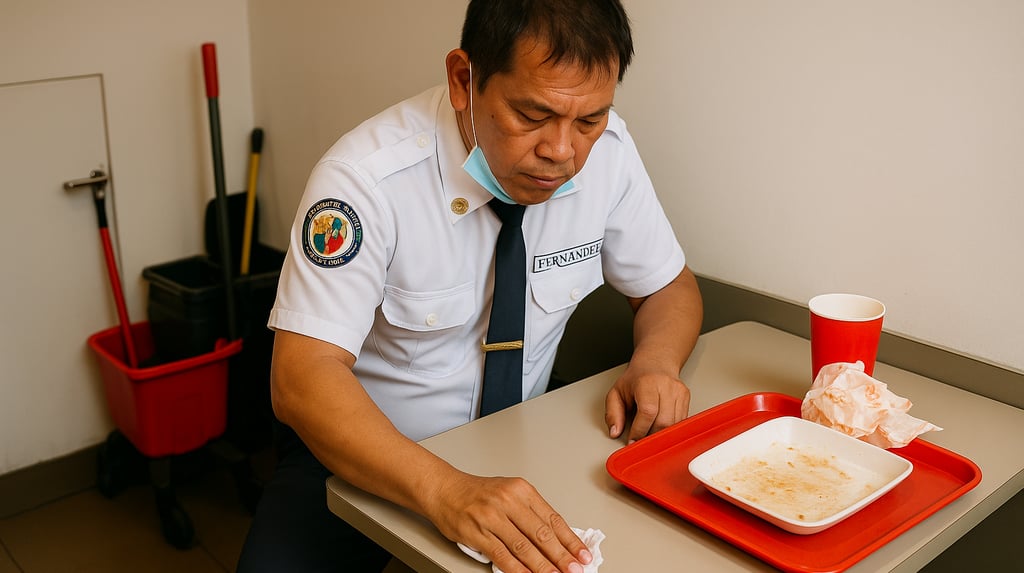Better Pay and Smarter Tech: The Key to Safer Private Security in the Philippines
In a time of rising crime and evolving threats, the Philippines’ private security sector stands at a crossroads. This article explores the urgent need to improve labor practices and embrace modern technology to ensure our guards are not only protected, but empowered to protect others. Based on recent research and real-world incidents, it presents a compelling case for why better pay and smarter tech are critical to national safety.
PHYSICAL SECURITY
Dr, Derek Presto, DBA
5/7/20256 min read


A Growing Concern: Security Threats in the Philippines
On August 2, 2023, six armed men with military-grade weapons brazenly robbed a jewelry store in Cagayan de Oro just minutes after it opened. Months later, on New Year’s Eve, criminals tunneled through a mall's concrete floor in Ozamiz City, stealing over ₱41 million in cash and jewelry. These incidents exploit holiday security lapses and reflect a troubling trend: the security threats facing communities and businesses in the Philippines are becoming increasingly complex. The need for reliable and modern private security services has never been more urgent, especially given the rise in violent armed robberies and large-scale cyberattacks, such as the PhilHealth ransomware breach that compromised the data of 13 million Filipinos. Despite this pressing need, many of the Philippines' 500,000 private security guards remain underpaid, undertrained, and lack proper equipment. The country must take decisive action to professionalize and modernize its private security industry. Fair compensation and innovative technology are essential.
A Vast Security Workforce, Undervalued and Overstretched
With over 500,000 licensed security guards employed across more than 2,100 registered agencies, the Philippine private security workforce is larger than the national police force. These guards protect banks, malls, factories, schools, residential communities, and government institutions. Security experts frequently emphasize that the police alone cannot meet the public's safety demands, making private security a vital “force multiplier.”
However, those entrusted with public safety often lack protection themselves. Numerous studies and industry accounts confirm that this profession is burdened by low wages, long hours, and high turnover rates. Officers earn just above the minimum wage and endure 12-hour shifts in high-stress environments. In comparison, some delivery riders reportedly earn more in a few hours than security guards do in an entire day. With limited benefits and low morale, attrition rates of 20% to 30% annually are common, driving experienced personnel away. High turnover means constant retraining and lower service consistency. In short, a poorly treated security workforce compromises public safety.
Labor Violations: Undermining Security from Within
One of the key challenges is the widespread occurrence of labor violations. Although laws such as RA 11917 and DOLE’s Department Order 150-16 mandate minimum wages, benefits, and a 20% administrative fee to ensure fair pay, many agencies disregard these rules. The enforcement of these regulations remains fragmented—while the PNP oversees licensing, DOLE monitors labor compliance, creating oversight gaps. Some contractors continue to bid low and then recoup costs by skimping on wages. Security managers report that this undercutting often results in unpaid overtime and unsustainable workloads.
These exploitative practices not only harm guards but also endanger the public. Exhausted and underpaid personnel are more likely to be inattentive or demotivated, increasing the risk of lapses in security. High turnover replaces experienced guards with less trained personnel, further compromising service consistency. In extreme cases, mistreated guards may engage in inside jobs. Treating guards as expendable assets degrades overall security. Agencies must treat guards as skilled professionals: they should be paid on time, given rest days, and have legal standards upheld. Clients also share responsibility, as Philippine law holds them jointly liable for labor violations committed by contracted agencies. Labor compliance should not be viewed merely as a checkbox but as a vital investment in safety.
Cheap Contracts, Costly Consequences
A root cause of non-compliance is the industry’s fixation on cost-cutting. Security contracts are often awarded to the lowest bidder, leading agencies to slash guard salaries, skimp on training, and ignore technological upgrades. Although the sector generates an estimated ₱60 billion annually, the thin profit margins among thousands of competing firms incentivize dangerous corner-cutting. A seemingly “affordable” contract may result in short-staffed or inadequately equipped security posts.
For example, a shopping mall that hires the cheapest agency might have guards without radios or proper weapons, or they may be required to work double shifts. This may seem adequate until a coordinated robbery occurs, similar to the incidents in Cebu or Cagayan de Oro. The supposed savings quickly disappear amidst stolen property, litigation, or, worse, casualties. RA 11917’s 20% minimum service fee rule aims to prevent undercutting. Some clients, particularly in sensitive sectors like energy or technology, are now vetting agencies based on reputation rather than cost. This best practice must become widespread. Fair contracts lead to better pay, training, and resources, resulting in enhanced protection for the public.
An Evolving Threat Landscape: From Holdups to Hacking
The threats that security guards face today have shifted dramatically beyond petty theft or trespassing. They now contend with well-armed robbery syndicates employing military tactics, as exemplified by gunmen in Mindanao carrying M4 rifles. Criminals are also impersonating authorities, as seen in a recent robbery in Cebu. Traditional security protocols are no longer sufficient to address these evolving challenges.
In addition to physical threats, digital vulnerabilities are on the rise. The ransomware attack on PhilHealth serves as a stark reminder that cybercrime has become a significant national concern. Security services now have to encompass both physical and digital realms. Many incidents now involve a combination of physical intrusion and technological manipulation, such as disabling CCTV systems or tampering with access controls. Global surveys indicate growing fears that digital vulnerabilities can lead to physical breaches, and agencies lacking basic cyber-awareness are putting themselves at serious risk.
Fortunately, integrated security solutions are gaining traction. AI-assisted CCTV, GPS-enabled patrol monitoring, and cross-trained personnel capable of managing both physical and digital risks are becoming standard in leading organizations. However, many smaller agencies still lag behind. Criminals tend to target the weakest links, so technological preparedness needs to be universal, not just reserved for elite contracts.
Technology: The Missing Force Multiplier
Despite global advancements in security technology, most security guards in the Philippines still rely on outdated tools such as flashlights, batons, and manual logbooks. Innovations like smart sensors, facial recognition, and predictive surveillance can significantly enhance situational awareness and reduce reliance on sheer manpower. For instance, guard tour systems now utilize mobile apps and QR codes to track patrols, while body-worn cameras can deter misconduct and support investigations.
There are familiar barriers to modernization: cost, lack of training, and fear of client pushback. However, clinging to outdated methods is a greater risk. Automated alarms and incident-reporting systems can reduce response times and help prevent escalation. Agencies that invest in technology report fewer incidents and higher client satisfaction. Moreover, these tools can attract younger, tech-savvy recruits, alleviating recruitment challenges within the industry. Smart technology doesn’t replace guards; it empowers them.
A Call to Modernize: Professionalize to Protect
The path forward is clear: private security agencies must combine fair labor practices with technological adoption. These are essential components, not luxuries, for adequate security. A recent mixed-methods study of Philippine providers found that compliance with wage laws had the most significant impact on service quality, closely followed by investment in innovation. In short, well-paid and well-equipped guards deliver better service.
For agency owners, the lesson is to view labor law compliance and modernization not as burdens but as competitive advantages. Firms that prioritize their workforce and invest in technology will outperform their competitors. For clients, the message is to stop rewarding the lowest bidder and begin demanding professionalism. They should evaluate providers based on labor practices, training, and technological capabilities. Policymakers must strengthen enforcement, close legal loopholes, and support the industry’s evolution through incentives, certification programs, or stricter penalties for repeat violators.
Ultimately, the quality of private security affects all sectors—from malls and business process outsourcing (BPO) firms to schools and infrastructure. The risks of ignoring reform are now too great. A professional, well-compensated, and tech-enabled security force is not only better for guards; it is also safer for the public.
References:
Bangko Sentral ng Pilipinas. (2022). Philippine Financial System: Status Report. Retrieved from https://www.bsp.gov.ph
Department of Labor and Employment (DOLE). (2016). Department Order No. 150-16: Rules on the Administration and Enforcement of Labor Laws. Retrieved from https://www.dole.gov.ph
Hair, J. F., Hult, G. T. M., Ringle, C. M., & Sarstedt, M. (2022). A Primer on Partial Least Squares Structural Equation Modeling (PLS-SEM) (3rd ed.). Sage Publications.
House of Representatives. (2022). Republic Act No. 11917 – An Act Strengthening the Regulation of the Private Security Industry. Retrieved from https://www.officialgazette.gov.ph
Lacson, A. (2023, September 28). PhilHealth ransomware attack compromises data of 13 million Filipinos. GMA News. Retrieved from https://www.gmanetwork.com
Magsambol, B. (2020, March 3). Hostage-taker at Greenhills mall surrenders after hours-long standoff. Rappler. https://www.rappler.com
Manila Bulletin. (2024, January 1). P41 million worth of jewelry, cash stolen from mall in Ozamiz. https://mb.com.ph
Manila Standard. (2023, December 11). Gunmen loot CDO jewelry store in broad daylight heist. https://manilastandard.net
Philippine News Agency (PNA). (2023, July 22). PNP, SOSIA strengthen compliance checks for security agencies. https://www.pna.gov.ph
Philippine National Police – SOSIA. (2023). Annual Report on Private Security Agency Licensing and Violations. Quezon City: PNP.
Philippine Association of Detective and Protective Agency Operators (PADPAO). (2023). Industry Position Paper on Labor Compliance and Technology Adoption.
Presto, D. (2025). Labor Compliance and Innovation as Drivers of Service Quality in Philippine Private Security: A Mixed-Methods Study. Unpublished doctoral dissertation, Polytechnic University of the Philippines.
Rappler. (2023, October 17). Delivery riders earn more than minimum wage earners, says economist. https://rappler.com
Security Industry Authority (UK). (2023). The Future of Private Security: Workforce and Innovation. Retrieved from https://www.gov.uk
Stratbase ADR Institute. (2022). The Role of Private Security in National Resilience. Policy Brief.
The Philippine Star. (2023, October 30). Rising threats from cybercrime highlight need for integrated security. https://philstar.com
Villanueva, J. (2023). Security Technology Trends in Southeast Asia: Adoption Gaps and Opportunities. Asian Journal of Security Studies, 9(2), 45–67.
World Economic Forum. (2023). Global Risk Report: Interconnected Security Threats and Vulnerabilities. https://www.weforum.org
Contact
contact@bathalasolutions.com
